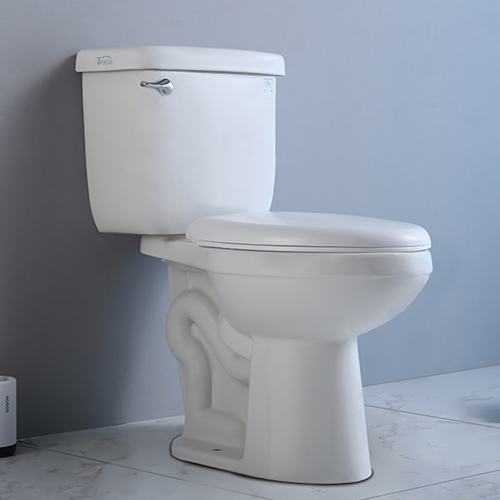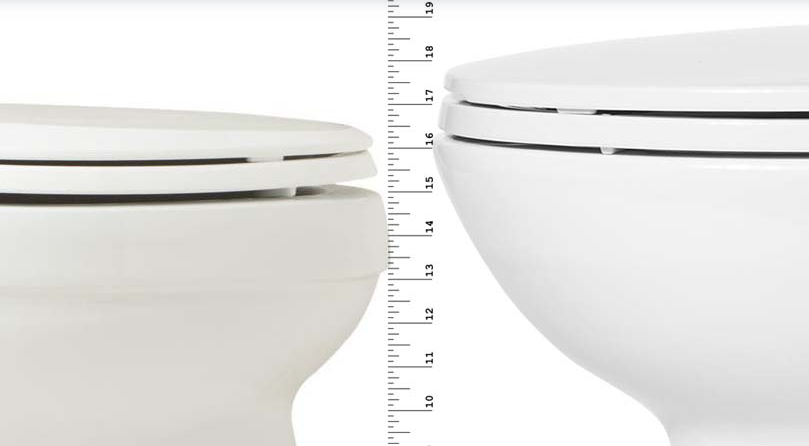How to Choose Your Best Bathroom Toilet? Your Toilet Buying Guide
are an integral part of any bathroom. Whether you’re in the midst of a remodel or your old toilet is leaking and needs replacing, you’ll be faced with several options when choosing a new bathroom fixture. Bathroom toilets come in many shapes, sizes, and styles, including one-piece and two-piece toilets, tall toilets and standard toilet height, large toilet and small toilet.
We’ll outline the differences below so that you can make a better choice for your bathroom toilet.
A.Types of Toilets
One of the simplest decisions to consider is whether you should go with a one-piece toilet or a two-piece one.


Two-Piece Toilets
Two-piece toilets have a separate tank and bowl, which are attached during the process of installation. They’re the most common option available and the more popular choice of the two among homeowners. This is largely because they’re typically more affordable than one-piece toilets, as well as being a bit easier to install.
In summary:
- Affordable.
- Easy to install.
- Commonly available.
One-piece Toilets
While they’re not quite as common as two-piece toilets, you can also expect to see a variety of one-piece toilets in your search as well. This type of toilet will generally cost more than those that come in two-pieces, but are easier to clean since there are fewer crevices to worry about.
In summary:
- Cost more.
- Easier to clean.
B.Types of Toilet Bowls
Round toilet or elongated toilet, does it matter? Let's go through it!
One of the most basic things to understand about your toilet is if it features 'round toilet bowls' or 'elongated toilet dimensions'. This refers to the measurement from the seat bolt holes to the tip of the toilet bowl.
The round toilet dimensions generally has a dimension of approximately 16.5" from the seat bolt holes to the tip of the bowl. A compact elongated toilet is approximately 2" longer, or about 18.5". (Note: these dimensions can change from manufacturer to manufacturer, but there is almost always about a 2" difference between the 2 sizes).
The easiest way to figure out what you have is to measure. Here is a comparison of two typical OVS toilet seats; remember, if it is approximately 16.5", you have a round toilet bowl. If it is approximately 18.5", you have an elongated bowl.
Elongated Toilets
Pros and Cons:
Pros: Elongated bowls are generally considered to be more attractive and comfortable than round front bowls, but as with most things, this is a matter of taste and can be affected by an individual's height and weight. Elongated bowls are also considered more 'hygienic' in that the larger surface area of the bowl makes is easier for men and children to use with less mess. The longer bowl size is also a requirement for ADA use, and the longer/wider bowl is generally easier to use for those with mobility issues.
Cons: The primary reason some don't choose an elongated bowl is space. In very small bathrooms, an elongated bowl simply might not fit or, might feel too crowded. (In some rooms we have dealt with over the year, the extra inches meant that the bathroom door literally couldn't close! In a space that tight, it's always important to measure first!) Also, if a bathroom is primarily being used by small children, the larger opening size can be more difficult for them to negotiate. But remember, children do grow, and there are children's 'potty seats' to help in the early years. You want your toilet to last a long time, so it really makes sense to choose based on long term, rather than short term needs.
Round Toilet
Pros and Cons:
Pros: Space! Round toilets for small bathrooms! And one piece toilet round bowl is also a better fit for small children, (but see above; this is a temporary 'pro').
Cons: Most people prefer the appearance of an elongated bowl. Also, the smaller surface area of a round bowl toilet dimensions tends to be more difficult for children and men to use without accidental mess, so it's a bit less hygienic.
So, take a look at your space and decide which choice is best for you! There are no 'wrong' choices - as long as they are informed choices).
C.Height of Toilet Bowls

Standard Height Toilet vs Comfort Height Toilet
Comfort Lies in Your Perception, Not the Bowl
Generally, the term comfort height is used to describe a toilet with its bowl height, measured from the floor to the top of the toilet seat (not including the cover) to be anything between 17 to 19 inches high. These height range is the same as an ADA toilet height. Anything that's lower than 17 inches, it's a standard toilet size. Or higher than 19 inches, it will be a non-standard toilet with an Exception clause to 604.4 of the American Disability Act for toilet seats.
Is comfort height toilet better than standard toilet?
Most people are more and more embracing comfort height toilets because of the benefits that they come with. They are the most ideal toilets for physically impaired people, old and generally tall people.
Let us not look at the pros and cons of comfort height toilets and see if they are something you would consider or you are better off buying a standard height toilet.
Comfort Toilet
PROS
- ADA-compliant
- Easy to sit and stand from
- No need for toilet risers
- Best for tall people
- Great choice for seniors
CONS
- They are Heavy
- Uncomfortable for kids and short people
- Can’t fit in a tight space
Standard Toilet Dimensions
Standard height toilets are the oldest type of toilets, between them and comfort height toilets. Although comfort height toilets are growing in popularity, standard height toilets still have their place.
So why should you buy a standard height toilet instead of a comfort height toilets? Are standard height toilets better than comfort height toilets? Let us look at their pros and cons.
PROS
- Best for kids, short and people of average height
- Can fit in a tight spot
- Better user position
- lighter
CONS
- Non ADA-compliant
- User-unfriendly to the disabled, old and tall people
- Might need a raised toilet seat
D.Types of Toilet Flush
One of the most important functionalities that every toilet offers is the flush. In your search for the best flushing toilet, you will come across models that treat this essential function differently. Here are the most common types of flushing options you’ll see.

Siphon Toilet Flush
Siphonic flushing toilets are the most common type you’ll encounter. As the name suggests, the design of this type of toilet takes advantage of gravity to release water from the tank when you pull on the flush lever. The velocity of water leaving the tank is how the toilet moves the contents of the bowl into the drain.
They’re popular for good reason. It’s a tried and true design that works well. Gravity-flush toilets are affordable and simple to repair.
In summary:
- Affordable.
- Easy to repair.
- The most popular option in homes.
Pressure Assisted Toilets
Pressure assisted toilets used to only show up in commercial spaces because of their cost, but as the technology becomes more affordable they’ve become more common in homes as well. They include a compression tank in addition to the water tank that provides additional pressure to pull the water and waste down when flushed than gravity can provide on its own. Thus, this type of toilet provides a more powerful flush and uses less water while doing so.
In summary:
- More powerful flush that uses less water.
- Often more expensive than gravity feed toilets.
- Smaller size.
Tankless Toilets
Tankless toilets replace the traditional tank of water most toilets use with a water line that’s attached directly to the bowl. Not having a water tank means they use up a lot less space and are thus a good choice for anyone with an especially small bathroom.
They require that you have either especially high water pressure, or purchase extra components that use electricity to power the flush. That means installation can be a little complicated if you don’t have the proper level of water pressure to support a tankless toilet (as most private residences don’t).
They tend to offer a cleaner, simpler design than toilets with a tank, which some people prefer from an aesthetic perspective.
In summary:
- Good for small spaces.
- Require either powerful water pressure or electricity to work.
- Clean design.
Dual Flush Toilet
Dual flush toilets combine the best of two worlds by allowing water efficiency without risking the ability to properly flush waste. They give you two options for flushing based on your level of need (whether it’s number one or number two, to be a bit more specific), so you can more actively save water without having to worry about extra flushing or dealing with a clogged toilet all those times when a little more water and power is called for.
In summary:
- Allow for efficient use of water.
- Reduce likelihood of clogging.
Final Summary
Having any toilet at all is a nice benefit of modern life, but taking the time and potentially spending a little extra to get one that’s more comfortable, efficient, or looks just right can make the time you spend in your bathroom a little bit nicer. Hope you can get your best toilet.

